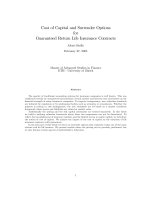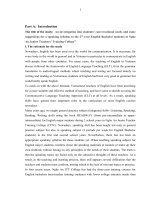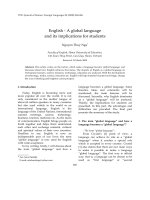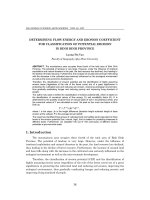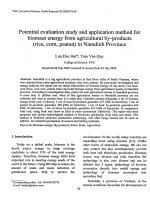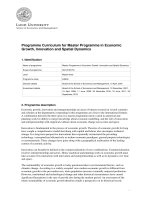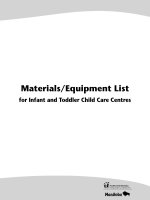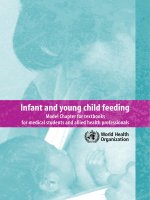CONNECTIONS: INFANT AND TODDLER CURRICULUM FOR RESPONSIVE CAREGIVING, 24-36 MONTHS ĐIỂM CAO
Bạn đang xem bản rút gọn của tài liệu. Xem và tải ngay bản đầy đủ của tài liệu tại đây (1.2 MB, 73 trang )
Table of Contents
I. Introduction…………………………………………………………………………………………………………………..2
II. Responsive Caregiving……………………………………………………………………………………………………7
III. Centers and Interest Areas…………………………………………………………………………………………..13
IV. Scope and Sequence…………………………………………………………………………………………………….26
V. Big Ideas……………………………………………………………………………………………………………………….28
VI. Templates…………………………………………………………………………………………………………………….55
VII. Daily Communication……………………………………………………………………………………………………58
VIII. Child Development Background Information……………………………………………………………….59
IX. Appendices…………………………………………………………………………………………………………………..60
a. Tips for Transitions…………………………………………………………………………………………………60
b. Validating Children’s Emotions………………………………………………………………………………61
c. Toilet Learning……………………………………………………………………………………………………….62
Connections: d. Stages of Play…………………………………………………………………………………………………………64
Infant and Toddler Curriculum for e. Teacher Made Light Table………………………………………………………………………………………65
Responsive Caregiving,
24-36 Months f. Master Book List…………………………………………………………………………………………………….66
The enclosed instructional guidance may be used for educational, non-profit g. Songs……………………………………………………………………………………………………………………..69
purposes only. If you are not an Early Learn or NYC DOE Head Start provider, send
an email to to request permission to use this h. Recipes…………………………………………………………………………………………………………………..72
document or any portion thereof. Please indicate the name and location of your
school or program and describe how you intend to use this guidance. X. Bibliography…………………………………………………………………………………………………………………73
I. INTRODUCTION this time is one of rapid expressive many tasks independently. Sometimes
vocabulary development as well. As you they tackle new tasks successfully. Other
Welcome to Connections: Infant and dig into new topics of exploration with times they feel defeat as they discover
Toddler Curriculum for Responsive your children, be sure to build your own they still need the help of an adult.
Caregiving, 24-36 Months. From 24-36 background knowledge accordingly so you Sometimes their desires coincide with the
months children may seem to be experts can provide them with the new language world around them, other times they
in some areas, and still have much to learn and information they are so excited to experience disappointment when their
in other areas. This dichotomy can make have. Your continued attention to talking own ideas do not align with the adults in
for a fun, exciting, and eventful year! with your children and responding to all of their lives. Navigating this year requires
their language use remains important much kindness and patience on the part of
During this year of life children are often during this time. the caregiver. For more information on
thirsty for new information and may seem the emotional experience of a two year
to pick up tidbits of knowledge about an This year, similar to the previous two, is old, and validating their emotions, see
assortment of topics, especially topics also one of continued rapid physical Sections VII Child Development
they find interesting. For example, you development. While a young two may still Background Information and VIII
may hear a two year old chatting about a be unsteady on their feet, by three years, Appendices.
vehicle using technical language typical of most children are running, climbing and
a mechanic. To foster this thirst for balancing well. This piece of the Connections curriculum,
information, the activities in this third and like all pieces, is designed to support
final piece of the Connections curriculum One area where children’s development caregivers in engaging in responsive care
are structured around very concrete ideas may seem less rapid is in effective that is grounded in child development
that lend themselves well to learning new strategies for sharing emotions, or basics. It includes child development
knowledge and specific information. As communicating their desires. Twos are information, strategies, and cues to
you dig into these big ideas with your infamous for tantrums and challenging support reflection as well as activity ideas
children, note what they find most behavior. This is typically due to the to try to with children. As always, it is
interesting and tailor the experiences you difficulty of understanding their own extremely important to get to know the
facilitate accordingly. emotions within the constructs of the families of the children you serve. Work
world around them. This skill is often hard with your families to understand their
During this stage, children also increase for adults, and is especially hard for the values and caregiving practices and use
their command over language. They will young child. At two, children are ripe with this knowledge as well as what you see
likely understand far more language than a sense of autonomy, as well as a desire to children do each day to guide your
they can produce, but for many toddlers, please the adults in their lives, but are still classroom caregiving practices. Some of
developing the physical skills to engage in
2
the strategies and content in this experiences they have together that are
document may need to be modified to meaningful to them and reflect on what
better serve the families in your program. you see children doing and saying when
For example, Section II Responsive they are in your care. Use this reflection to
Caregiving references young children make decisions about the topics you
learning to eat with a spoon. While this explore with your class, as well as the
may be something that applies to some individual activities you offer them each
families, it may not apply to all. Language day.
and communication preferences are also
important areas for connection with
families. It is important to make an effort
to provide resources for families in their
home language, and highlight the
importance of their child continuing to
learn their home language in your
classroom and beyond. Additionally,
whenever possible, communicate with
families in the method that works best for
them. For example, some families may
prefer written notes about their child’s
day, while others may prefer online
communication.
While the ideas in this curriculum may
inspire fun and learning, your relationships
with the children in your classroom are
the foundation for high quality care. As
you make decisions about daily care and
activities, begin by considering what you
know about your children and families.
Consider asking families to share what
they see their children doing at home,
3
Connections: Responsive Caregiving for Infants and Toddlers
The New York City Department of Education Connections curriculum is designed to support infant and toddler educators in providing responsive care. The
curriculum offers guidance for caregivers of children from 6 weeks through 3 years and is comprised of three sections: 6 weeks to 12 months, 12-24 months,
and 24-36 months. Connections is grounded in research on developmental expectations as described in the Head Start Early Learning Outcomes Framework:
Ages Birth to Five (ELOF), which outlines the development programs support as they engage with our youngest children. By using Connections as written,
programs will ground their practice in the expectations and expertise of the ELOF. Teaching staff should refer to the ELOF when implementing Connections in
order to connect their observations of each child with ELOF goals and to guide their planning as they work to meet the needs of all children in their care.
Guiding Principles of the Early Learning Outcomes Framework:
Each child is unique and can succeed. Children are individuals with different rates and paths of development. Each child is uniquely influenced by their
prenatal environment, temperament, physiology, and life experiences. With the appropriate support, all children can be successful learners and achieve the
skills, behaviors, and knowledge described in the Framework.
Learning occurs within the context of relationships. Caring families, teachers, and other adults matter in a young child's life. Responsive and supportive
interactions with adults are essential to children's learning.
Families are children's first and most important caregivers, teachers, and advocates. Families must be respected and supported as the primary influence in
their child's early learning and education. Their knowledge, skills, and cultural backgrounds contribute to children's school readiness.
Children learn best when they are emotionally and physically safe and secure. Nurturing, responsive, and consistent care helps create safe environments
where children feel secure and valued. In these settings, children are able to engage fully in learning experiences.
Areas of development are integrated, and children learn many concepts and skills at the same time. Any single skill, behavior, or ability may involve
multiple areas of development. For example, as infants gain fine motor skills, they can manipulate objects in new ways and deepen their understanding of
cause and effect. As preschoolers gain new verbal skills, they can better manage their emotions and form more complex friendships.
Teaching must be intentional and focused on how children learn and grow. Children are active, engaged, and eager learners. Good teaching practices build
on these intrinsic strengths by providing developmentally appropriate instruction and opportunities for exploration and meaningful play.
Every child has diverse strengths rooted in their family's culture, background, language, and beliefs. Responsive and respectful learning environments
welcome children from diverse cultural and linguistic backgrounds. Effective teaching practices and learning experiences build on the unique backgrounds
and prior experiences of each child.
Early Learning Outcomes Framework Domain Organization
Click here to access the Guiding Principles of the Head Start Early Learning Outcomes Framework online
6
II. Responsive Caregiving
24 months-36 months
I can do it!
Every child is unique with their own needs, wants, and desires. However, there are some behaviors and characteristics typical to each stage of
development, as well as responsive approaches and strategies adults can use that encourage growth and development. Use this chart to reflect
on children’s behaviors and your own responses. Note that caregivers should always begin by engaging with families to learn about their
routines and beliefs around sleeping, diapering, and eating. Modifications may need to be made to the Adults Should category in order to align
classroom practices with family culture. Additionally, family culture may influence child development and impact the Children Often category.
SLEEPING DIAPERING CHILDREN OFTEN ADULTS SHOULD CHILDREN WILL BE LEARNING
Sleep about 11-14 hours per day, Talk to families about their sleep To sleep well and to sleep on their own.
including a nap. routines. Whenever possible, use the
same routines the family uses.
Experience disruptions or shifts Stick to a regular daily schedule which To feel safe and secure in the classroom which
in their sleep patterns due to includes plenty of time for the child to leads to smooth transitions to sleep. To feel
development such as increased nap. known and cared for which will help them
motor, cognitive and social Note children’s sleep habits and changes develop secure attachments.
abilities, and an increasing drive in sleep habits. Remain flexible to
for independence. changing routines as children’s sleep CHILDREN WILL BE LEARNING
CHILDREN OFTEN needs change. To develop body awareness, by listening to
ADULTS SHOULD their body and understanding how their body
Begin to develop control over their feels before and after going to the bathroom.
bladder and bowels. Talk to families about their
Shows increasing interest in diapering/toileting routines and beliefs. To develop a sense of discomfort when in a
bathroom habits of others’. Whenever possible, align practices to the soiled diaper and in turn communicate that
families’ preferences. they are in need of a diaper change.
Note children’s habits when starting to To coordinate their body to do all the
consider toilet learning. Children are components involved in toileting, which will
generally ready to use the toilet when help them use the toilet successfully.
they:
7
Connections: Infant and Toddler Curriculum for Responsive Caregiving, 24-36 Months
• Stay dry for longer periods of
time.
• Notice when they are urinating or
having a bowel movement.
• Are physically able to sit on a
toilet or small potty chair, and
manipulate their clothing for
successful toileting (e.g. pull
pants up and down).
• Are interested in toileting
behaviors.
• Can follow simple directions.
EATING CHILDREN OFTEN See Section VI. Appendices for CHILDREN WILL BE LEARNING
information and resources on toilet
learning.
ADULTS SHOULD
Talk to families about their feeding
routines and beliefs. Whenever possible,
align practices to the families’
preferences.
Express opinions about food and may Avoid power struggles around food. Offer That their feelings and opinions matter in the
seem to become picky eaters. 3-4 healthy options and let the child classroom and to develop their individual taste
determine which items, and how much to palette.
eat.
Introduce new flavors, textures, and To move toward a more sophisticated diet and
foods that are nutrient rich since toddlers develop preferences for healthy foods.
have small stomachs. Avoid foods that
pose a risk for choking. Watch for allergic
reactions and respond promptly if
concerns arise.
8
Connections: Infant and Toddler Curriculum for Responsive Caregiving, 24-36 Months
Feed themselves independently, Let children feed themselves. Supply food To control their fine motor muscles and
mostly still using their fingers and a that is safe for children to eat on their develop increasing dexterity and eye-hand
spoon, but with increased dexterity own, but always supervise and support coordination, moving towards mastery.
and coordination will move towards mealtimes. Provide children with a Develop increasing autonomy in feeding and
using other utensils. combination of finger food and food that ability to use dishes and utensils at mealtime.
requires a utensil to decrease frustration
Drink from a cup. and increase dexterity. To master the combination of fine motor skills
Provide children with access to cups and mouth muscle control required to drink
Skip meals. when drinking water and milk. Begin from an open cup.
providing cups without tops as children
are ready. That their feelings and opinions matter in the
Offer children three healthy meals and classroom and to listen to their bodies’ hunger
two or three healthy snacks per day but cues. This is essential in developing healthy
allow children to skip meals and/or eating habits.
snacks if they indicate this need.
CHILDREN OFTEN ADULTS SHOULD CHILDREN WILL BE LEARNING
9
Connections: Infant and Toddler Curriculum for Responsive Caregiving, 24-36 Months
PLAYING Show interest in each other, begin to Facilitate opportunities for children to do Pro-social skills, including how to play with
interact in social situations and fun and engaging activities together, others, similarities and differences between
participate in small group activities. ensuring that there are enough materials self and others, collaboration, and preferences
and space. Use language to connect in playmates.
children’s ideas and thoughts to one
another.
Act impulsively and get distracted Provide safe, predictable and consistent To identify their emotions, and begin to
easily. responses to children’s behavior. internalize strategies for obtaining materials
Validate feelings and set clear and other children are using.
consistent age-appropriate limits.
Continue to develop the strength and Provide children with a variety of New and increasingly complex gross motor
coordination to move and use their opportunities to practice using their skills. Awareness about their body, what it can
bodies in more complex and bodies in progressively more complex do and its limitations. Spatial reasoning, as they
coordinated ways, including climbing ways, always using encouragement and experiment with how their bodies fit in the
up and down stairs, jumping off the positive reinforcement. spaces around them.
ground, balancing on one foot, and
kicking and throwing a ball.
Use their hands and fingers to Provide children with a variety materials To develop increasing control and strength in
manipulate objects with increasing and objects that encourage children to their fingers and hands. As children develop
control and complexity use their fingers and hands in more fine motor skills, they are gradually able to
complex ways, such as twisting, turning, complete important tasks, such as, feeding
cutting (with child safe scissors), and oneself, buttoning and zippering, and writing.
drawing.
Want to do things on their own. Allow children to do tasks independently Self-care skills, persistence, problem solving
as interested and the environment abilities, an increased sense of self-confidence,
allows. Plan for the extra time required in and a healthy appetite for and attitude towards
this “I can do it myself,” stage. Remain learning.
10
Connections: Infant and Toddler Curriculum for Responsive Caregiving, 24-36 Months
Use 2-4 word phrases to patient and provide guidance when you New words and language skills such as creating
communicate, begin to string phrases notice children becoming frustrated. increasingly longer sentences, engaging in
together, and move into using more Listen to children and talk with them as conversations, and using language understand
complete sentences. they play and explore the world. Narrate the why and how things work.
their actions as well as your own. Use
both familiar and new vocabulary as
children play.
Follow 2-step directions that may be Give children 2-step directions To hold information in their brain while they
unrelated. throughout the day in a variety if complete one task in order to then complete an
contexts and settings. additional task. This supports the development
of working memory.
Ask and understand “what,” “where,” Ask questions that require more than a That their curiosity is valued and that there are
and “why” questions. yes-or-no answer and patiently respond answers to their questions.
to children’s “why” questions.
Locate or label familiar objects when Provide vocabulary for new objects that Increased vocabulary and that everything has a
asked and knows own name. children discover. Provide the word(s) name.
for things children point to. Ask children
Spend a lot of time in the world of to point to familiar objects, such as, About symbols, that an object can represent
pretend. This can lead to great fun, “where’s your nose?” something else. Symbolic play helps children
and new found fears, as 2-year-olds Engage in imaginative play with children, develop the skills necessary to learn later skills
cannot always separate pretend from following their lead. Carefully observe like reading and math. Pretend play also helps
reality. children’s pretend play, noticing what children cope with or process difficult
thoughts and feelings might be showing situations and begin to understand the
up. Provide materials that may spark differences between what is real and what is
imaginative play. imagined.
Model desired behaviors, language and
actions.
11
Connections: Infant and Toddler Curriculum for Responsive Caregiving, 24-36 Months
Imitate the actions of caring adults Provide children choices throughout the How the world works, self-care routines, new
and other children. day. Remind children of routines and skills, language, cultural and social behavior,
everyday activities. Allow children to and an awareness of self vs. other.
Remember past experiences, favorite play with or hold preferred objects.
objects, activities and people. About themselves and their preferences as well
as the predictability of routines and schedules.
The ability to maintain focus for longer periods
of time and show increasing persistence while
interacting with people or engaging in
activities.
12
Connections: Infant and Toddler Curriculum for Responsive Caregiving, 24-36 Months
III. Centers and Interest Areas to share their experience and demonstrating excitement over their
discoveries will help children feel safe and secure in the classroom
Play is essential to the two year old’s care experience. Adequate and increase their ability to take in new information.
time to engage in play is required each day. To create a structure
that lends itself well for play, Connections: Responsive Caregiving As children develop and their interests change, opportunities to
for Infants and Toddlers, 24-36 months, is structured around six extend their learning will arise. Consider how materials and
centers and interest areas. These centers and interest areas include activities can support this. For example, consider using a limited
Blocks/Construction, Dramatic Play, Art/Writing, Sensory/Science, number/type of blocks at the beginning of the year and adding
Math/Manipulatives, and Library. The following pages outline and/or rotating the selection as children are ready. When children
materials and strategies to support play-based learning and express interest in specific ideas, add materials to support this play.
responsive instruction in centers and interest areas. Each center For example, if children are very interested in taxis, add toy taxis to
begins with an overview of how children may engage with the the center.
center across the program year, language adults can use to support
learning, a suggested text, materials suggestions as well as ideas to Open-ended questions can also extend children’s play by helping
engage with communities, and connect the learning the child does them to think further. Additionally, they allow children to share
at school with their home experience. Additionally each page details about their play, thought process, and plans, remove the
includes a template to support planning that begins by supporting need for adult assumptions, and the likelihood of adults
observation, provides connections to the ELOF, and encourages misunderstanding of the play. Consider using open-ended
teaching teams to reflect on their observations as they plan. A questions as you play with children, but do not yet expect children
blank copy of the planning template can be found in Section VI to answer. As children become more familiar with this process,
Templates. The materials suggested in this section do not create an develop an increasingly sophisticated vocabulary, as well as the
exhaustive list of classroom materials. Additionally, materials ability to plan and share thoughts they may begin to respond to
related to specific studies should also be added to each center to open ended questions.
support children’s further understanding of specific content. See
Section IV Activities for topic related suggestions.
Remember that while adding materials to an area inspires children’s
play, much of the learning that happens at this age is based on the
relationships between adults and children. Sitting at their level,
allowing them to explore independently to then come back to you
13
Connections: Infant and Toddler Curriculum for Responsive Caregiving, 24-36 Months
Blocks/Construction PLANNING
OBSERVE: How are children interacting with the blocks?
“Children learn more from what you are, than what you teach.”
W.E.B. Du Bois • Observing other children
• Holding and exploring shapes
IN THIS CENTER, children will likely explore the properties of blocks. They will • Carrying and moving them around the center/room
use their senses to gain information by holding, feeling and looking. They may • Laying them flat
choose to carry blocks around or lay them side by side. Some children may • Stacking
choose to stack blocks and knock them down repeatedly. Additionally, they may • Other:
use blocks for other purposes, such as pretending they are cars and pushing What can I learn about children’s hand-eye coordination from the way they
them around on the floor. At this age, children may choose to play alone or near use the blocks and materials?
their peers.
What interests or play themes are emerging as children play?
NARRATION TO SUPPORT LEARNING:
Note, use expression and vary your inflection when reflecting on children’s work in order to Other observations:
spark joy and wonder
CONNECT: How do my observations link to skills children are developing
• You are ______ the blocks. and align with ELOF goals?
• I notice you are _____ with the blocks. Goal IT-PMP 6. Child coordinates hand and eye movements to perform actions
• You are using the ____ blocks. Goal IT-PMP 7. Child uses hands for exploration, play and daily routines.
• It looks like you are working really hard with the blocks. Goal IT-C 12. Child uses objects or symbols to represent something else.
What other ELOF goals do these observations support?
SUGGESTED TEXT: Whose Tools Are These? by Toni Buzzeo
INFORM PRACTICE: What are my next steps in response to children’s skills
MATERIALS: UNIT BLOCKS and interests?
• Wood or plastic in a variety of shapes such as rectangles, squares,
triangles and cylinders
• Hollow cardboard blocks • Foam blocks
• Foam blocks • Soft cloth blocks
• Homemade blocks constructed for cardboard boxes
• ABC blocks that are larger than 2 inches in diameter
MATERIALS: ACCESSORIES
• Toy people • Toy vehicles and trucks
• Tree blocks
• Toy animals typical to the children’s environment (e.g., pets, or animals
of high interest)
• Pictures of structures that are familiar to the children (e.g., program
building, neighborhood landmarks, famous NYC landmarks)
14
Connections: Infant and Toddler Curriculum for Responsive Caregiving, 24-36 Months
MATERIALS: RECYCLED AND NATURAL ITEMS
• Large tubes (e.g., cardboard mailing tubes)
• Empty paper towel tubes • Empty tissue boxes
• Assorted sticks
EXTENSIONS
See Section IV Activities, for specific activity ideas related to each Big Idea.
FAMILY AND COMMUNITY ENGAGMENT SUGGESTION
Capture children’s structures throughout the year by taking pictures.
Periodically send the photos home. Consider individual photos or a book that
demonstrates what children have done and how they have grown in block
building.
15
Connections: Infant and Toddler Curriculum for Responsive Caregiving, 24-36 Months
Art/Writing Note: Children have varying levels of sensitivity to sensory experiences. Do not
force children to touch materials. Invite children to participate and observe their
“It took me four years to paint like Raphael, but a lifetime to paint like a child.” behavior carefully. Respond to the cues they give you about their readiness to
Pablo Picasso participate.
IN THIS CENTER, children will likely explore art materials in a physical PLANNING
way. Children may be more interested in exploring the properties of the OBSERVE: What are children doing with the materials in the center?
art materials, and how they work than the end result. For example, some
children may want to dump paint and put their hands in it, while other • Exploring the properties of the materials
children may want to explore how the paint moves off the brush as they • Working with a purpose
move their arms. Additionally, children may explore drawing by making • Engaging in representative art
marks on paper, without intentionality or representation. As their fine • Engaging very briefly
motor skills strengthen, they may move from holding the crayon or • Engaging for a longer period of time
marker with a palm grasp to a tripod grasp. • Seeking sensory experiences
• Avoiding sensory experiences
NARRATION TO SUPPORT LEARNING • Other:
Note, use expression and vary your inflection when reflecting on children’s work in What interests or play themes are emerging as children play?
order to spark joy and wonder
Other observations:
• You are using ____________. • It seems like you enjoy ________.
• You are watching ________, ________. CONNECT: How do my observations link to skills children are
• I notice you are ________ with ______. developing and align with the ELOF goals?
• When you _______, ________ happened. IT-ATL 7. Child persists at task
• You are making (shape or type of line). IT- ATL 9. Child demonstrates flexibility in thinking and behavior.
SUGGESTED TEXT: Little Blue and Little Yellow by Leo Lionni IT-PMP 8. Child adjusts reach and grasp to use tools.
What other ELOF goals do these observations support?
DRAWING MATERIALS
INFORM PRACTICE: What are my next steps in response to children’s
• Large crayons, markers, pencils, and chalk skills and interests?
• Construction paper • Large sheets of paper
• Butcher paper • Tin foil
• Contact paper • Cellophane
• Tissue paper • Felt
PAINTS • Watercolor paint
• Finger paint • Liquid watercolor paint
• Tempera paints
• Stamp pads
16
Connections: Infant and Toddler Curriculum for Responsive Caregiving, 24-36 Months
THREE-DIMENSIONAL MATERIALS
• Paper towel tubes • Large wood pieces
Large spools
• Pipe cleaners •
TOOLS
• Large paint brushes • Paint rollers
• Smocks • Easel
• Stamps • Sponges
• Glue sticks • All purpose glue
• Spill-proof paint containers • Child-safe scissors
Masking, washi, or colored tape
• Drying rack or other place for artwork to dry
RECYCLED AND NATURAL MATERIALS
• Wood pieces • Flowers
• Leaves • Stems
• Sticks • Thin cardboard pieces
• Corrugated cardboard pieces • Paper scraps
• Paint samples • Wallpaper samples
• Sandpaper • Fabric scraps
• Popsicle sticks • Ribbons
• Small and medium boxes
EXTENSIONS
See Section IV Activities, for specific activity ideas related to each Big
Idea.
FAMILY AND COMMUNITY ENGAGEMENT SUGGESTION
Ask families to keep an eye out for recycled and natural materials children
might be able to use in art. For example, old fabric scraps, pieces of paper,
discarded jewelry may be interesting to explore in this center. Families can
also look for natural materials near where they live such as flowers, leaves,
or sticks and add them to the art materials in this center.
17
Connections: Infant and Toddler Curriculum for Responsive Caregiving, 24-36 Months
Dramatic Play PLANNING
OBSERVE: How are the children engaging in this center?
“Let the child be the scriptwriter, the director and the actor in his own play”
*See Appendix D for Stages of Play
Magda Gerber
• Playing alone
IN THIS CENTER, children will likely explore by feeling and touching fabrics • Observing peers
and other materials. They may choose to observe how other children • Engaging in parallel play
interact with materials. Some children may play alongside their peers and • Engaging in associative play
use materials in a functional way such as putting on clothing. They may • Engaging in cooperative play
mimic experiences from their lives, such as cooking or taking care of babies. • Using materials in a functional manner
Children may also use this center to explore themselves and learn about who • Engaging in symbolic play
they are. Additionally, they may be exploring the early stages of perspective • Other:
taking by acting out situations such as the separation process. They may What interests or play themes are emerging as children play?
choose to take on the caregiver’s role and give emotions to others. For
example, they may decide a baby is sad or instruct an adult to be sad What emotions do the children appear to explore as they play?
because they have to go to work (Galinsky, 2010; Stern, 1973).
Other observations:
NARRATION TO SUPPORT LEARNING:
Note, use expression and vary your inflection when reflecting on children’s work in order CONNECT: How do my observations link to skills children are
to spark joy and wonder developing and align with the ELOF goals?
Goal IT-C 12. Child uses objects or symbols to represent something else.
• You are _____ with your baby. Goal IT- C 13. Child uses pretend play to increase understanding of culture,
• You have _____ lots of things on/in your ______. environment, and experience.
• It looks like you are working hard to ______. Goal IT-SE 6. Child learns to express a range of emotions.
• You put the ____ on/in the _____. What other ELOF goals do these observations support?
SUGGESTED TEXT: Julián is a Mermaid by Jessica Love INFORM PRACTICE: What are my next steps in response to children’s
skills and interests?
PROPS AND MATERIALS
18
• Stuffed animals • Child-sized furniture
• Mirrors • Puppets
• Telephones
• Pretend food of various cultures
• Brooms and dust pan and/or mop and bucket
• Kitchen utensils reflective of the classroom community (e.g., bowls,
plates)
• Open-ended loose parts such as small blocks, wood rings, and pegs
• Furniture related to baby care such as cribs, highchairs, strollers,
changing table, etc.
• Materials for baby care reflective of the classroom community (e.g.
clothing and blankets)
Connections: Infant and Toddler Curriculum for Responsive Caregiving, 24-36 Months
• Baby dolls representing various skin colors and ethnicities
• Pictures of children’s family members at home and work
• Children’s transitional items from home
DRESS UP
• Costumes and costume related items that connect to children’s lives
such as train conductor costume, train schedule, walkie-talkie, medical
jackets and equipment such as stethoscopes, blood pressure cuffs,
bandages, etc.
• Various fabric scraps to inspire costume creation according to children’s
interests, needs, and cultures
• Various clothing related items such as dresses, dress shirts, suit coats,
aprons, scarves, ties, necklaces, brief case, purses, glasses frames, sun
glasses
FANTASY
• Various items related to fantasy play that connect to children’s lives
such as animal costumes, stuffed animals, crowns, capes and fancy
gowns
RECYCLED AND NATURAL MATERIALS
• Empty and clean takeout containers and lids
• Empty and clean cereal/ food boxes and/or containers
• Empty and clean soap and laundry containers
• Empty egg cartons
EXTENSIONS
See Section IV Activities, for specific activity ideas related to each Big Idea.
FAMILY AND COMMUNITY ENGAGEMENT SUGGESTION
As children become interested in specific topics, consider asking local
business that may specialize, or supply items related to the topic to donate
materials to use in dramatic play. Additionally, consider asking families to
share items as applicable, or visit the classroom to play with the children in
the center, if they are knowledgeable about a particular topic or interest
area. Be sure to communicate to all families that bringing in materials is not
required for the child to participate in the center.
19
Connections: Infant and Toddler Curriculum for Responsive Caregiving, 24-36 Months
Library PLANNING
OBSERVE: How are children engaging with books in this center?
“Any book that helps a child to form a habit of reading, to make reading one of
his deep continuing needs, is good for him.” • Independently
• With peers
Maya Angelou • Exploring the physical properties of books
• Exploring the illustrations and text in books
IN THIS CENTER, children will likely interact with books in a physical way • Holding the book right side up
and focus on how books feel, and move. Others may be interested in • Turing pages, one at a time
exploring books independently to discover what is on the pages. Children • Sharing information about the book
are most likely to enjoy books and stories that match their interests, are • Reciting language from the book
active, engaging and include straightforward, yet interesting illustrations. At • Other:
this age, children may prefer books with simple texts and clear rhythms.
Children may also enjoy reading and rereading the same book multiple What types of books and stories does the child seem to especially
times and may demonstrate this by bringing it to an adult to read to them. enjoy?
NARRATION TO SUPPORT LEARNING: Other observations:
Note, use expression and vary your inflection when reflecting on children’s work in order
to spark joy and wonder CONNECT: How do my observations link to skills children are
developing and align with the ELOF goals?
• I notice you looking at that Goal IT- SE 1. Child develops expectations of consistent, positive
book. interactions through secure relationships with familiar adults.
Goal IT-LC 10 Child handles books and relates them to their stories or
• You are turning the pages. information.
• Look, there is a ____ on this page. Goal IT- LC 12. Child comprehends meaning from pictures and stories.
• It looks like you want me to read this book with you. Let’s sit and What other ELOF goals do these observations support?
read together. INFORM PRACTICE: What are my next steps in response to children’s
skills and interests?
BOOKS
• See Section VI Texts for content-related text suggestions
• Supplement content-related titles with other books from the Master
Book List that support the needs and interests of your children
MATERIALS
• Puppets • Stuffed animals
• Throw pillows
• Soft rug
• Magnetic surface and magnetic pieces related to books children
especially enjoy and can easily retell
EXTENSIONS
See Section IV Activities, for specific activity ideas related to each Big Idea.
20
Connections: Infant and Toddler Curriculum for Responsive Caregiving, 24-36 Months
FAMILY AND COMMUNITY ENGAGEMENT SUGGESTION
Share children’s favorite books with their families. If children enjoy reading a
particular book, or hearing a particular story at home, ask families to tell you
about it, or if possible share the book with the class. The book could be
placed in the classroom library, or a family member could come in and read,
or share a favorite family story.
Families may also be interested in creating books about their time together
away from school. For example, they may like to write a story about their
weekend, or their trip to school. Staple a few pages of blank paper together
to create a book. If necessary, allow families to borrow writing or drawing
utensils to use to create their books. Alternatively, families could record
themselves telling a favorite family story. Invite families to share their
stories in the language of their choice.
21

